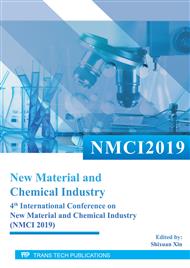[1]
R. Chen, H. Lai, D. Cui and Y. Zhu. Alkali-activated mortar for tunnel-lining structure repair. Journal of Materials in Civil Engineering 31 (2019) 04019217.
DOI: 10.1061/(asce)mt.1943-5533.0002857
Google Scholar
[2]
L. Jin-long, O. Hamza, K. Sian Davies-Vollum and L. Jie-qun. Repairing a shield tunnel damaged by secondary grouting. Tunnelling and Underground Space Technology 80 (2018) 313-321.
DOI: 10.1016/j.tust.2018.07.016
Google Scholar
[3]
M. Ramli and A. Akhavan Tabassi. Effects of polymer modification on the permeability of cement mortars under different curing conditions: A correlational study that includes pore distributions, water absorption and compressive strength. Construction and Building Materials 28 (2012) 561-570.
DOI: 10.1016/j.conbuildmat.2011.09.004
Google Scholar
[4]
C. Schröfl, V. Mechtcherine and M. Gorges. Relation between the molecular structure and the efficiency of superabsorbent polymers (SAP) as concrete admixture to mitigate autogenous shrinkage. Cement and Concrete Research 42 (2012) 865-873.
DOI: 10.1016/j.cemconres.2012.03.011
Google Scholar
[5]
X.J. Xiang, J.W. Qian, W.Y. Yang, M.H. Fang and X.Q. Qian. Synthesis and properties of nanosilica-reinforced polyurethane for grouting. Journal of Applied Polymer Science 100 (2006) 4333-4337.
DOI: 10.1002/app.23306
Google Scholar
[6]
W.A. Thanoon, M.S. Jaafar, M.R. A. Kadir and J. Noorzaei. Repair and structural performance of initially cracked reinforced concrete slabs. Construction and Building Materials 19 (2005) 595-603.
DOI: 10.1016/j.conbuildmat.2005.01.011
Google Scholar
[7]
A.P. Mouritz and I.M. Hutchings. Compressive failure of silica-filled epoxy resins influence of matrix strength, interfacial bond strength and porosity. Journal of Materials Science Letters 11(1992) 1100-1103.
DOI: 10.1007/bf00730844
Google Scholar
[8]
B. Jiang, K.H. Oh, S.Y. Kim, XY. He and S.K. Oh. Technical evaluation method for physical property changes due to environmental degradation of grout-injection repair materials for water-leakage cracks. Applied Sciences 9 (2019) 1740.
DOI: 10.3390/app9091740
Google Scholar
[9]
B. Pang, Y. Zhang, G. Liu and W. She. Interface Properties of Nanosilica-Modified Waterborne Epoxy Cement Repairing System. ACS applied materials & interfaces 10 (2018) 21696-21711.
DOI: 10.1021/acsami.8b04092
Google Scholar
[10]
T. Chen, C. Peng, C. Liu, C. Yuan, J. Hong, G. Chen, Y. Xu and L. Dai. Modification of epoxy resin with a phosphorus, nitrogen, and fluorine containing polymer to improve the flame retardant and hydrophobic properties. Macromolecular Materials and Engineering 304 (2018) 1800498.
DOI: 10.1002/mame.201800498
Google Scholar
[11]
H. Wu, Y. Li, B. Zeng, G. Chen, Y. Wu, T. Chen and L. Dai, A high synergistic P/N/Si-containing additive with dandelion-shaped structure deriving from self-assembly for enhancing thermal and flame retardant property of epoxy resins. Reactive and Functional Polymers 131 (2018) 89-99.
DOI: 10.1016/j.reactfunctpolym.2018.07.009
Google Scholar
[12]
F. Sun, T. Yu, C. Hu and Y. Li. Influence of functionalized graphene by grafted phosphorus containing flame retardant on the flammability of carbon fiber/epoxy resin (CF/ER) composite. Composites Science and Technology 136 (2016) 76-84.
DOI: 10.1016/j.compscitech.2016.10.002
Google Scholar
[13]
X. Wang, Y. Hu, L. Song, W. Xing, H. Lu, P. Lv and G. Jie. Flame retardancy and thermal degradation mechanism of epoxy resin composites based on a DOPO substituted organophosphorus oligomer. Polymer 51 (2010) 2435-2445.
DOI: 10.1016/j.polymer.2010.03.053
Google Scholar
[14]
Z. Bai, L. Song, Y. Hu, X. Gong and R.K.K. Yuen. Investigation on flame retardancy, combustion and pyrolysis behavior of flame retarded unsaturated polyester resin with a star-shaped phosphorus-containing compound. Journal of Analytical and Applied Pyrolysis 105 (2014) 317-326.
DOI: 10.1016/j.jaap.2013.11.019
Google Scholar
[15]
I. Butnaru, M. Fernández-Ronco, J. Czech-Polak, M. Heneczkowski, M. Bruma and S. Gaan. Effect of meltable triazine-DOPO additive on rheological, mechanical, and flammability properties of PA6. Polymers 7 (2015) 1541-1563.
DOI: 10.3390/polym7081469
Google Scholar
[16]
X. Tao, H. Duan, W. Dong, X. Wang and S. Yang. Synthesis of an acrylate constructed by phosphaphenanthrene and triazine-trione and its application in intrinsic flame retardant vinyl ester resin. Polymer Degradation and Stability 154 (2018) 285-294.
DOI: 10.1016/j.polymdegradstab.2018.06.015
Google Scholar
[17]
D. Shen, Y.J. Xu, J.W. Long, X.H. Shi, L. Chen and Y.Z. Wang. Epoxy resin flame-retarded via a novel melamine-organophosphinic acid salt: Thermal stability, flame retardance and pyrolysis behavior. Journal of Analytical and Applied Pyrolysis 128 (2017) 54-63.
DOI: 10.1016/j.jaap.2017.10.025
Google Scholar
[18]
L.J. Qian, Y. Qiu, J. Liu, F. Xin and Y.Y. Chen. The Flame Retardant Group-Synergistic-Effect of a Phosphaphenanthrene and Triazine Double-Group Compound in Epoxy Resin. Journal of Applied Polymer Science (2014) 39709.
DOI: 10.1002/app.39709
Google Scholar
[19]
P. Wang and Z. Cai. Highly efficient flame-retardant epoxy resin with a novel DOPO-based triazole compound: Thermal stability, flame retardancy and mechanism. Polymer Degradation and Stability 137 (2017) 138-150.
DOI: 10.1016/j.polymdegradstab.2017.01.014
Google Scholar
[20]
M. Long, S. Peng, W. Deng, X. Miao, N. Wen, Q. Zhou, X. Yang and W. Deng. A robust superhydrophobic PDMS@ZnSn(OH)6 coating with under-oil self-cleaning and flame retardancy. Journal of Materials Chemistry A 5 (2017) 22761-22771.
DOI: 10.1039/c7ta06190k
Google Scholar
[21]
Y.C. Jung and B. Bhushan. Wetting behavior of water and oil droplets in three-phase interfaces for hydrophobicity philicity and oleophobicity philicity. Langmuir 25 (2009) 14165-14173.
DOI: 10.1021/la901906h
Google Scholar
[22]
T. Na, H. Jiang, L. Zhao and C. Zhao. Preparation and characterization of novel naphthyl epoxy resin containing 4-fluorobenzoyl side chains for low-k dielectrics application. RSC Advances 7 (2017) 53970-53976.
DOI: 10.1039/c7ra09941j
Google Scholar
[23]
P. Glaris, J.F. Coulon, M. Dorget and F. Poncin-Epaillard. Surface migration of fluorinated additive during the curing of epoxy resin. Composites Part B: Engineering 73 (2015) 10-15.
DOI: 10.1016/j.compositesb.2014.12.020
Google Scholar
[24]
L.N. Sim, S.R. Majid and A.K. Arof. FTIR studies of PEMA/PVDF-HFP blend polymer electrolyte system incorporated with LiCF3SO3 salt.Vibrational Spectroscopy 58 (2012) 57-66.
DOI: 10.1016/j.vibspec.2011.11.005
Google Scholar
[25]
Y.Q. Xiong, Z.J. Jiang, Y.Y. Xie, X.Y. Zhang and W.J. Xu. Development of a DOPO‐containing melamine epoxy hardeners and its thermal and flame‐retardant properties of cured products. Journal of Applied Polymer Science (2013) 37635.
DOI: 10.1002/app.37635
Google Scholar
[26]
X.J. Feng, L. Feng, M.H. Jin, J. Zhai, L. Jiang and D.B. Zhu. Reversible super-hydrophobicity to super-hydrophilicity transition of aligned ZnO nanorod films. Journal of the American Chemical Society 126 (2004) 62-63.
DOI: 10.1021/ja038636o
Google Scholar


